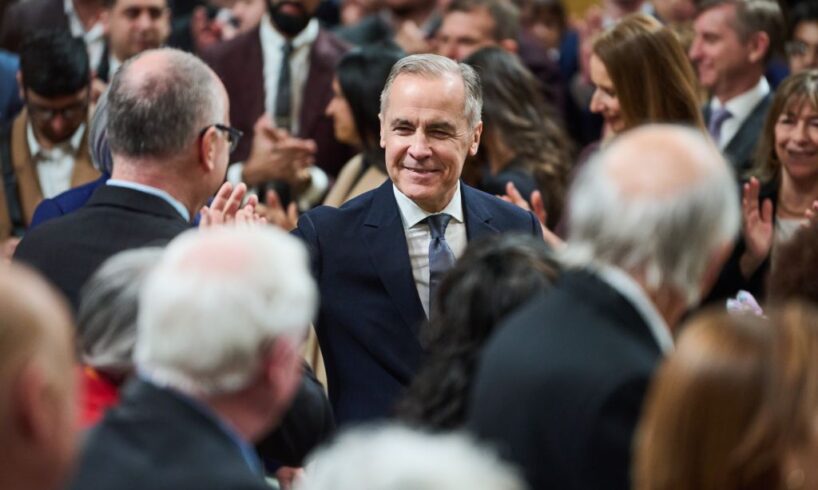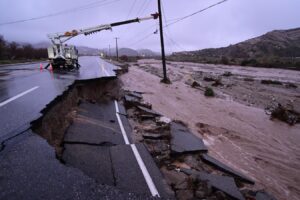
Prime Minister Mark Carney’s first budget proposes cancelling or changing climate rules and initiatives, while cutting billions of dollars in planned environment spending and reorienting funds to “supercharge growth.”
The government tabled its 2025 federal budget documents in Parliament on Nov. 4. In a speech, Finance Minister François-Philippe Champagne said the world is undergoing fundamental shifts that are upending the international order and hurting Canadian workers, and that “bold and swift action is needed.”
That action includes weakening a key law that clamped down on industry greenwashing.
It also includes drawing down spending at two federal agencies involved in environmental oversight, and winding down two high-profile climate programs: the Canada Greener Homes Grant and the 2 Billion Trees program.
Premier Mark Carney promised action on climate change before he was elected, but the new federal budget suggests industrial initiatives are his government’s top priority. Photo: Kamara Morozuk / The Narwhal
The budget suggests Prime Minister Mark Carney’s government is likely to scrap a Trudeau-era plan to put a cap on emissions from the oil and gas sector, while investing in largely unproven technology that proposes to lower emissions from fossil fuel production.
“We will explore new markets and sell more of the best of what Canada has to offer. We will build here at home — stronger industries, nation-building infrastructures and millions of more homes for Canadians,” Champagne said.
“We will protect what matters most: our people, our communities and our sovereignty. And, we will empower Canadians by making life more affordable, creating new career opportunities and ensuring every generation can get ahead.”
The federal budget is the government’s plan for spending and financial priorities. As a result, it’s considered a matter of confidence in Parliament, meaning failure to pass it would trigger an election. The Liberals have a minority and must get a few opposition members to vote with them or abstain from voting in order to pass the budget. The vote is expected to be held Nov. 17, after Parliament debates the budgetary motion this week and breaks next week for Remembrance Day.
Cuts to planned spending at Environment, Fisheries and Oceans and other departments
The government is proposing to cut a total of $1.3 billion in projected spending at Environment and Climate Change Canada over the next several years, in line with its push to meet savings targets and “streamline” programs.
The spending cuts won’t be fully realized until after 2030. They are projected to occur in portions each fiscal year, with a final portion listed as “ongoing” with no end date.
The budget indicated the cuts will be widespread, coming from eliminating activities and programs, as well as ditching some lease agreements and training contracts and combining or simplifying other activities like engaging with Indigenous communities.
Carney’s spending cuts also affect two key environmental agencies. The government said the Impact Assessment Agency of Canada, which ensures big projects are assessed for environmental and societal protections, was expected to lose $65.8 million in spending over several years. As the federal government pushes for increased development, particularly in natural resources, the agency functions as a checkpoint.
The Canada Water Agency, which coordinates with provinces, territories and Indigenous communities to protect fresh water, would lose $5 million in spending over several years.
Meanwhile Natural Resources Canada, the department that oversees the fossil fuel sector, is also seeing proposed spending cuts of $2.6 billion past 2030.
That includes winding down programs like the Canada Greener Homes Grant, which provides loans for homeowners making energy efficiency upgrades, and ending the 2 Billion Trees program that supports tree-planting programs across the country but struggled to meet its own targets.
And Fisheries and Oceans Canada is expected to see spending cuts of $736.7 million over several years. The government said the department would “leverage artificial intelligence and other digital tools to modernize Canada’s fisheries management system.”
It also said it would scale back some efforts and wind down activities that “have either achieved their objectives or for which alternative data sources exist.”
Government weakens anti-greenwashing law
The government said it would be rolling back some of the stronger measures Canada put into law last year to combat greenwashing — when companies make environmental claims without evidence.
The budget proposed removing two critical parts of Canada’s Competition Act that were added in 2024 to crack down on greenwashing, and would also take away a newly added power of third parties to bring greenwashing complaints to the Competition Tribunal directly.
The government said these rules had been “creating investment uncertainty” since they were introduced, and were “having the opposite of the desired effect.”
But Conor Curtis, head of communications at Sierra Club Canada, said weakening greenwashing rules is “more than just a problem for the climate, it is a problem for the security of our democracy.”
“What we are seeing in the United States in terms of a breakdown of democratic processes, rights and freedoms, is in large part due to the spread of disinformation and specifically of climate denial,” Curtis said in a statement.
“This climate denial and delayist messaging has often been purposefully spread by oil and gas corporations to undermine democratic processes.”
The Liberals’ new budget scraps some of the measures implemented in 2024 to combat corporate greenwashing — when companies make environmental claims without evidence. Critics fear ditching these regulations represents a threat to both climate and democracy. Photo: Isabella Falsetti / The Narwhal
For years, six large oilsands companies organized under the lobby group Pathways Alliance — Suncor, Cenovus, Imperial Oil, Canadian Natural Resources, ConocoPhillips Canada and MEG Energy — had told Canadians through advertising campaigns at the Super Bowl, on public transit and on social media that they were “making clear strides toward net zero” and that they intended to achieve “net-zero emissions from oilsands operations by 2050.”
The claim was related to their proposal to build a large carbon capture and storage network in Alberta using technology that has not been tested at that scale. The Pathways Alliance set about trying to convince the government to help fund large portions of the project.
But its net-zero claim was the subject of a formal complaint in 2023 by Greenpeace Canada. The environmental group said the companies were misleading Canadians because they had no plans to phase out oil production — and only intended to tackle the carbon pollution generated during their operations, not from burning the fossil fuels they produce.
Canada’s anti-greenwashing rules were designed to scrutinize these kinds of sweeping environmental claims. They say any company’s claims about the environmental benefits of a “business or business activity” can be challenged if they aren’t backed up with evidence in line with an “internationally recognized methodology.”
When these rules were introduced, fossil fuel companies and lobby groups immediately complained, saying they were vague or overreaching. The oil company alliance, for example, scrubbed their websites and social media feeds of all claims it was trying to reach net-zero emissions.
While the group said the move was “not related” to the truth of its claims, one of the lawmakers who helped get the rule into place told The Narwhal at the time it was “very telling” that the group had pulled information offline so soon after the rules came into effect.
The alliance also told the Competition Bureau that the anti-greenwashing language created “significant legal uncertainty for businesses making virtually any type of communication that relates to the environment or climate change, regardless of the purpose of the communication and the intended audience.”
This fall, Carney announced that the Pathways Alliance proposal had the eye of the government and would be examined for potential referral to its Major Projects Office, which is supposed to help get projects built quicker.
The budget also commits to extending a key tax break for carbon capture investments — and it makes clear that the government is relying on the unproven technology for major emissions reductions going forward.
Climate strategy meant to help protect competitiveness of oil and gas sector
In the budget, the government also laid out its anticipated Climate Competitiveness Strategy, which “aims to maximize carbon value for money.”
The strategy is focused on Canada reducing its “carbon intensity,” the measure of how much carbon pollution goes into making a single unit of energy — for example, the amount of emissions generated per each barrel of oil.
By lowering the carbon intensity, the budget noted, Canada can sell more of its oil, gas, steel and aluminum to jurisdictions that are looking for “low associated greenhouse gas emissions.”
The federal government is focusing on reducing Canada’s carbon intensity — how much carbon goes into producing a single unit of energy — but this measure neglects the total emissions created by energy production, including by the fossil fuel industry. Photo: Amber Bracken / The Narwhal
“Lowering our emissions is critical to protecting the competitiveness of Canada’s oil and gas and steel sectors,” the budget stated.
“Reducing emissions is not only essential for environmental reasons, but also a key factor in securing access to markets that prioritize sustainability.”
Carbon intensity is not, however, a measure of the total level of emissions from energy production.
While Canada’s fossil fuel industry has lowered the emissions intensity for each barrel of oil it produces, the industry has also grown its oil production so its overall emissions have actually increased.
Canada likely won’t follow through with oil and gas emissions cap
The government said it would likely cancel plans to implement an emissions cap on the oil and gas sector in its climate strategy, which would align with an emphasis on capturing carbon to lower emissions.
The cap is supposed to be phased in starting in 2026. It’s meant to ensure oil and gas companies stick to their word that they can cut emissions, by ensuring the sector slashed carbon pollution 35 per cent by 2032, compared with 2019 levels.
It would be the first time Canada has imposed these kinds of mandatory, overall obligations on the industry, which is the country’s biggest carbon polluter.
Former prime minister Justin Trudeau’s government introduced a plan for an emissions cap on Canada’s oil and gas industry. Carney’s Liberals are prioritizing carbon capture and storage instead. Photo: Selena Phillips-Boyle / The Narwhal
As well, Canada, as the world’s fourth-largest oil producer and fifth-largest natural gas producer, would be the only large oil and gas producer in the world to have an emissions cap on its oil and gas industry.
After key industry players lobbied hard against the proposal, the Carney government has signalled it’s been lukewarm on the idea, which began under former prime minister Justin Trudeau.
In the budget, the government said the emissions cap would have only “marginal value” in reducing emissions when its other programs — like implementing stronger regulations for methane, a significant greenhouse gas and the main component of natural gas — were kept in place.
The government said it was also supporting technologies like carbon capture and storage, which are supposed to draw down carbon emissions from the sector. It also noted that large industrial emitters are still subject to a carbon pricing system even though Carney cut the consumer carbon tax in the spring.
Canada will change the rules for industrial carbon pricing, electricity tax break and redirect clean fuel funding
The government said it would be changing the benchmark it uses to ensure the different provincial and territorial industrial carbon pricing systems meet minimum federal standards, but offered few details.
It said it would set a new trajectory for the industrial carbon price “that targets net-zero by 2050.”
The government is planning to engage provincial and territorial governments “about improvements to the benchmark” and about pricing systems.
The changes are coming after the federal government has been under pressure to explain what it would do if provincial carbon pricing systems don’t comply with federal rules.
Alberta announced it would freeze its industrial carbon price at $95 per tonne through 2026, which means it wouldn’t meet the federal benchmark as of next year, which will be $110 per tonne.
But Alberta Premier Danielle Smith recently said she was open to changing the province’s industrial carbon pricing program after meeting with Carney.
Clean energy is a focus of the new federal budget, with a tax credit proposed for provincial and territorial Crown corporations investing in clean power projects. Previous environmental conditions for the tax credit have been eliminated, however. Photo: Leah Hennel / The Narwhal
The budget also proposes to move ahead with a tax credit for provincial and territorial Crown corporations investing in “clean electricity,” but without some environmental and equity conditions Canada has previously imposed.
In a budgetary update from December 2024, the government said that for the Crown corporations to access the tax credit, the governments responsible would have to commit, by the end of 2026, to publishing an “energy roadmap to achieve net-zero emissions by 2050.”
They were also supposed to “pass on the benefits” of the tax credit to electricity ratepayers in their jurisdiction.
Removing the conditions will cut down on “administrative burden,” the government said in the budget.
Creating a Youth Climate Corps, critical minerals fund and other initiatives
The budget proposes providing $40 million over two years, starting in the fiscal year 2026–27, for a Youth Climate Corps.
The money would flow through Employment and Social Development Canada, and is meant to provide skills training for young Canadians so they can respond to “climate emergencies” and help with recovery and community resilience.
The government also proposed creating a $2-billion Critical Minerals Sovereign Fund at Natural Resources Canada which will make “strategic investments in critical minerals projects and companies.”
It said it was exploring the creation of a pilot project “to enable on-reserve construction companies to bid for infrastructure projects” and another pilot project to “monetize federal transfers to support financing for First Nations infrastructure on reserve.”
Part of the new budget proposes initiatives for First Nations construction companies to bid on infrastructure projects and for Indigenous participation in the government’s new fast-tracked projects. Photo: Taylor Roades / The Narwhal
The budget also proposes $2.3 billion over three years to renew the First Nations Water and Wastewater Enhanced Program, so about 800 active projects, including some related to ending boil-water advisories, are maintained.
And it proposes funding for Indigenous participation in major projects. The Major Projects Office would receive $213.8 million over five years, some of which would support the Indigenous Advisory Council, which includes 11 representatives from First Nations, Inuit, Métis and Modern Treaty and self-governing communities.
Another $10.1 million over three years would go to Crown-Indigenous Relations and Northern Affairs Canada to continue leading the federal initiative that supports “meaningful participation of Indigenous rightsholders in consultation processes” while potential national-interest projects are reviewed.





